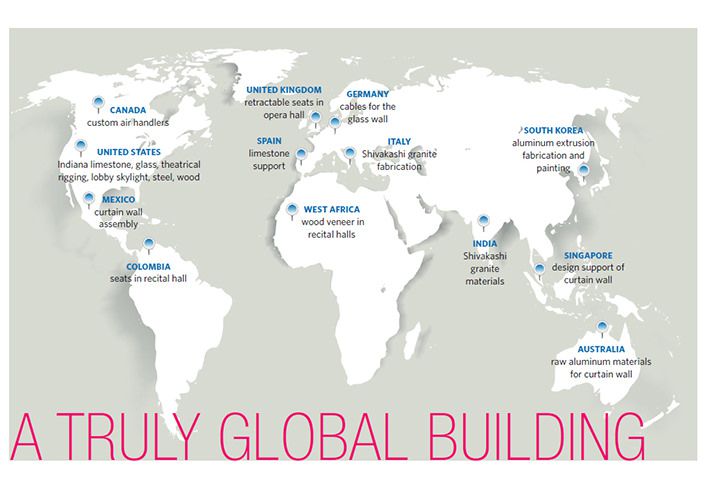By Marianne Goss
To a layperson, the choice of materials for the new Music and Communication Building may seem to pose conflicting goals: a dramatic architectural statement and unprecedented acoustical performance meant looking all over the world for materials, but LEED certification meant looking close to home. To project architect Patrick Loughran of Goettsch Partners, there was just one goal: “the right balance of local and imported materials.”
The US Green Building Council awards LEED (Leadership in Energy and Environ-mental Design) points for using materials extracted from, processed, and manufactured within 500 miles of the project. The new building looks to exceed LEED gold standards, and, for most needs, regional sources met the highest architectural as well as environmental standards. “But we reached beyond local borders for a few critical components in order to achieve the aesthetic and performance wishes of the University,” says Loughran. “World-class buildings require world-class materials.”
The three performance spaces—the recital, opera, and choral halls—are prime examples of using regionally sourced materials wherever possible and rare materials for a few critical components. Their exterior walls are clad with Indiana limestone by Illinois Masonry of Chicago, and the steel beams, catwalks, and stairs come from Waukegan Steel. Under the thin veneer of African moabi wood on the walls of the recital and choral halls is Forest Stewardship Council–certified wood from the United States. “The African wood is just a small fraction of the wood used in the final panels,” says senior project manager Chris Erickson of Power Construction, whose job involves not only overseeing construction but also procuring the materials for the new building. Loughran also notes that to build the walls and ceilings of the recital hall, “the most renowned craftsman in the world”—Imperial Woodworking—was found right in suburban Palatine.
Another blend of regional and international sources will make for a dramatic first impression in the lobby. The skylight is from a Milwaukee firm, Super Sky; the floor of Shivakashi granite was quarried in India and cut in Italy into irregular pieces to be fit together like a puzzle.
Nowhere are the components more critical than in the unique glass curtain wall on the building’s exterior. The high-performance acoustical facade was manufactured by an international curtain wall company, Benson Industries, based in Portland, Oregon, and the curtain wall’s design and fabrication were completed across the globe. Altogether, the glass wall represents five countries: the design, Singapore and the United States; raw aluminum, Australia; aluminum extrusion fabrication and painting, South Korea; glass, the United States; and, finally, assembly in Mexico, where all of those materials were put together into unitized sections before being shipped to the construction site.
“The materials traveled the world to get here,” says Erickson. “What we’ll have is a truly global building—with LEED certification.”
